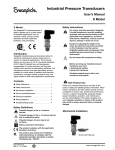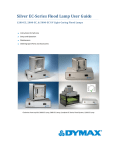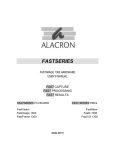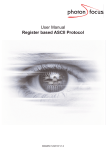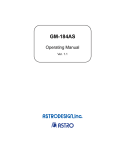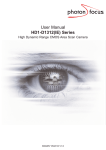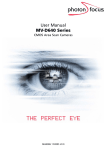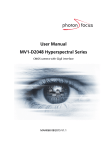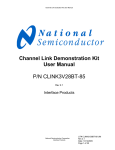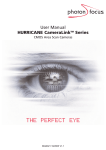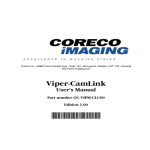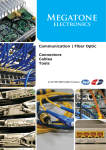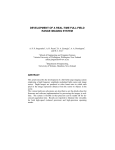Download Digipeater CLB26 User Manual
Transcript
User Manual Digipeater CLB26 CameraLink® Repeater THE PERFECT EYE MAN007 01/2008 V1.3 Digipeater CLB26 User Manual Digipeater CLB26 User Manual REVISION 1.3 © 2008 PHOTONFOCUS. About Photonfocus The Swiss company Photonfocus is one of the leading specialists in the development of CMOS image sensors and corresponding industrial cameras for machine vision. Photonfocus is dedicated to making the latest generation of CMOS technology commercially available. Active Pixel Sensor (APS) and global shutter technologies enable high speed and high dynamic range (120 dB) applications, while avoiding disadvantages, like image lag, blooming and smear. Photonfocus has proven that the image quality of modern CMOS sensors is now appropriate for demanding applications. Photonfocus' product range is complemented by custom design solutions in the area of camera electronics and CMOS image sensors. Photonfocus is ISO 9001 certified. All products are produced with the latest techniques in order to ensure the highest degree of quality. Contact Photonfocus AG, Bahnhofplatz 10, CH-8853 Lachen SZ, Switzerland Sales Support Phone: +41 55 451 00 00 Phone: +41 55 451 01 37 Email: [email protected] Email: [email protected] Sales Offices Photonfocus products are available through an extensive international distribution network; details of the distributor nearest to you can be found at www.photonfocus.com. Further information For further information on the products, documentation and software updates please see our web site www.photonfocus.com or contact our distributors. Photonfocus reserves the right to make changes to its products and documentation without notice. Photonfocus products are neither intended nor certified for use in life support systems or in other critical systems. The use of Photonfocus products in such applications is prohibited. Photonfocus and LinLog® are trademarks of Photonfocus AG. CameraLink is a registered mark of the Automated Imaging Association. Product and company names mentioned herein are trademarks or trade names of their respective companies. Reproduction of this manual in whole or in part, by any means, is prohibited without prior permission having been obtained from Photonfocus AG. Photonfocus can not be held responsible for any technical or typographical errors. REV: 1.3 Page 2/20 Digipeater CLB26 User Manual Index 1 2 3 4 5 6 7 8 9 10 11 12 13 14 15 16 Introduction ................................................................................................... 4 Connections / Block diagram ............................................................................ 5 Performance of the complete system ................................................................. 7 CameraLink® Interface and Power Supply........................................................... 9 Mounting of the Digipeater ............................................................................. 11 Technical Data for the Digipeater CLB26........................................................... 11 6.1 Technical features ................................................................................... 11 Configurations for Digipeaters......................................................................... 12 Applications ................................................................................................. 14 Ordering information ..................................................................................... 15 Appendix A – CE Compliance Statement........................................................... 16 Literature .................................................................................................... 17 11.1 Files on the web server www.photonfocus.com....................................... 17 Tables ......................................................................................................... 17 Figures........................................................................................................ 17 Revisions and State of Product development ..................................................... 18 14.1 Revisions .......................................................................................... 18 Service information ....................................................................................... 19 15.1 Contact for product enquiries and quotations ......................................... 19 15.2 Product information, documentation and software updates....................... 19 15.3 Storage and Transport........................................................................ 19 15.4 Preparing for use ............................................................................... 19 Guarantee conditions .................................................................................... 20 REV: 1.3 Page 3/20 Digipeater CLB26 User Manual 1 Introduction The Digipeater CLB26 is designed to overcome problems with image processing systems in which distance is a limitation. A standard CameraLink® cable can be used to connect a camera to a frame grabber over distances of up to 10 m. It frequently occurs, however, that twice this length is required to feed signal cables through the trunking of automation systems. The Digipeater CLB26 regenerates all data signals, including the control and communication signals of the CameraLink® base version. Thus, standard 10 m cables can be used to bridge distances of 20 m with no problem. Even connection distances of 30 m can be achieved by using high-grade cables (e.g. 3M part number 14B26-SZLB-xxx-0LC). Application specific cables and non standard custom cables can be obtained from Photonfocus. Fig. 1: Digipeater CLB28 front view Two Digipeaters CLB26 can be used in parallel for cameras with CameraLink® medium interface (see Fig. 10). For CameraLink® full cameras please use the Digipeater CLF52. REV: 1.3 Page 4/20 Digipeater CLB26 User Manual 2 Connections / Block diagram Fig. 2 shows a block diagram of the Digipeater. Data from the camera are connected to Port 1. The regenerated data are transmitted on to the frame grabber from Port 2. The direction of the data flow is marked with arrows on the Digipeater case (see Fig. 1). The de-jitter unit regenerates the PixelClock and enables the usage of long cables on the output port 2. The watchdog controls the transmitter for correct start when powering the device and restart after power interruptions. The serial communication interface is equipped with a fail save circuit to avoid communication error in all conditions, in particular in cases of cable brakes and short cuts. The CameraLink® interface is based on the LVDS standard for data transmission. The CameraLink® interface standard is described in [CLS2004]. Information about the LVDS standard can be found in [LOM2004], [IPS2006] and [CLD2006]. These documents are available from the Photonfocus Homepage www.photonfocus.com. It is important to understand that the CameraLink® interface is a high speed data transmission. The performance of the complete system depends on the high frequency performance of all components of the system. Digipeater CLB26 X0 Receiver Transmitter 24 Bit Data D0 ... D23 X1 X2 X1 X2 FVAL, LVAL, DVAL, SPARE X3 X3 Pixel Clock CLK De-Jitter Unit DSER X0 CLK R SER CameraLink R Frame Grabber PORT A Clock Control Camera Transmitter Receiver CC1 (EXSYNC) CC1 CC2 CC2 (MCLK) CC2 CC3 CC3 (CONTROL) CC3 CC4 CC4 (EXPOSURE) CC4 RX TX Receiver Transmitter Serial TFG Transmitter Receiver Serial TC Fail Save Transmision TX RX PORT 2 Frame Grabber PORT 1 Camera CC1 PORT B Watchdog Unit Fig. 2: Block diagram of the Digipeater REV: 1.3 Page 5/20 Digipeater CLB26 User Manual When installing cables in the vision system the cables have to be handled with extreme care to avoid destruction of the inner cable structure. Please do not apply extra force to the cables and mind the minimum bending radius. Otherwise the characteristic impedance of the cable will not be longer 100 Ohm and transmission errors or an interruption of the data transmission will occur. Cables for extreme conditions in drag chain and in robot applications can be ordered from Photonfocus. At higher transmission distances it is important that the data signals meet the common voltage range of the receiver. An important aspect is the grounding concept for the complete vision system. Error currents which are caused by mismatches of the characteristic impedances of system components are compensated via the inner shield of the cable. Fig. 3 shows the grounding and wiring concept for the CameraLink® interface standard. Fig. 3: Grounding concept for the CameraLink® interface REV: 1.3 Page 6/20 Digipeater CLB26 User Manual 3 Performance of the complete system The performance of the vision system is determined by the performance of the vision components at given bandwidth of the data transmission. The bandwidth of the CameraLink® interface is given by the bit depth of the camera, the number of taps and the transmission frequency (PixelClock frequency). The cable attenuation, the pair skews between the twisted pair cables in the CameraLink® cable and the clock jitter are the main limiting factors for the CameraLink® data transmission. To reach maximum transmission distances high performance cables have to be selected. Photonfocus uses high performance clock devices to reduce the clock jitter. To further enhance the jitter performance Photonfocus takes extreme care in the layout of the camera and repeater electronics. Fig. 4 shows the maximum transmission distance for different cable cross-sections as a function of the transmission frequency. The basis for this diagram is a worst case analysis for the complete transmission path. Losses on the connectors and losses trough poor layout of camera and frame grabbers are not taken in considerations. Photonfocus designs cameras and repeaters for optimal performance. 35.0 AWG 28 30.0 AWG 30 Cable Lenght / m AWG 32 25.0 20.0 15.0 10.0 5.0 0.0 0.0 10.0 20.0 30.0 40.0 50.0 60.0 70.0 80.0 90.0 Pixel Clock / MHz Fig. 4: Cable distance vs transmission frequency REV: 1.3 Page 7/20 Digipeater CLB26 User Manual In vision systems most often AWG28 CameraLink® cables are in use. Table 1 shows the distances for different configurations and transmission frequencies for an AWG28 CameraLink® standard cable. High performance cables, high flexible cables, cables for drag chains and robots are available from Photonfocus. Table 1: Overview over the transmission length with optimal selected components and AWG 28 standard cable Pixelclock 20 MHz 33 MHz 40 MHz 66 MHz 80 MHz REV: 1.3 without CLB26 20 m 15 m 13 m 10 m 9m 1 x CLB26 40 m 30 m 26 m 20 m 18 m 2 x CLB26 60 m 45 m 39 m 30 m 27 m 3 x CLB 26 80 m 60 m 52 m 40 m 36 m Page 8/20 Digipeater CLB26 User Manual 4 CameraLink® Interface and Power Supply The Digipeater has two sockets with signals for data transmission and the control of camera functions as well as one socket for external power supply. The pin assignments for the data and control signals are defined in the CameraLink® Standard [CLS2004]. Table 2 shows the pin assignments for Port 1 and Table 3 those for Port 2. The subminiature circular connector Binder Series 712 is used for power supply. The order number for the Digipeater socket is 09-0408-00-03 (see Table 4 and Fig. 5). Included with the Digipeater is a power supply plug, for which the order number is 990405-70-03. The use of clean power supplies for the Digipeater is advised. High voltage spices cause data transmission errors. Photonfocus delivers audited power supplies for the Digipeater CLB26. Table 2: Pin assignments for the MDR26 socket of the CameraLink® PORT 1 (Camera) PIN 1 2 3 4 5 6 7 8 9 10 11 12 13 14 15 16 17 18 19 20 21 22 23 24 25 26 S I/O PW I I I I O I O O O O O PW PW I I I I O I O O O O O PW PW REV: 1.3 Name SHIELD N_CC4 P_CC3 N_CC2 P_CC1 P_SERTOFG N_SERTOCAM P_XD3 P_XCLK P_XD2 P_XD1 P_XD0 SHIELD SHIELD P_CC4 N_CC3 P_CC2 N_CC1 N_SERTOFG P_SERTOCAM N_XD3 N_XCLK N_XD2 N_XD1 N_XD0 SHIELD SHIELD Description Shield Negative LVDS Input, Control signal CONTROL <not used> Positive LVDS Input, Exposure control EXPOSURE Negative LVDS Input, external clock for Slave mode MCLK Positive LVDS Input, external Trigger signal EXSYNC Positive LVDS Output, Serial Communication from the Camera Negative LVDS Input, Serial Communication to the Camera Positive LVDS Output, CameraLink® Data D3 Positive LVDS Output, CameraLink® clock Positive LVDS Output, CameraLink® Data D2 Positive LVDS Output, CameraLink® Data D1 Positive LVDS Output, CameraLink® Data D0 Shield Shield Positive LVDS Input, Control signal CONTROL <not used> Negative LVDS Input, Exposure control EXPOSURE Positive LVDS Input, external clock for Slave mode MCLK Negative LVDS Input, external Trigger signal EXSYNC Negative LVDS Output, Serial Communication from the Camera Positive LVDS Input, Serial Communication to the Camera Negative LVDS Output, CameraLink® Data D3 Negative LVDS Output, CameraLink® clock Negative LVDS Output, CameraLink® Data D2 Negative LVDS Output, CameraLink® Data D1 Negative LVDS Output, CameraLink® Data D0 Shield Shield Page 9/20 Digipeater CLB26 User Manual Table 3: Pin assignments for the MDR26 socket of the CameraLink® PORT 2 (Frame grabber) PIN 1 2 3 4 5 6 7 8 9 10 11 12 13 14 15 16 17 18 19 20 21 22 23 24 25 26 S I/O PW O O O O O I O I I I I PW PW O O O O O I O I I I I PW PW Name SHIELD N_XD0 N_XD1 N_XD2 N_XCLK N_XD3 P_SERTOCAM N_SERTOFG N_CC1 P_CC2 N_CC3 P_CC4 SHIELD SHIELD P_XD0 P_XD1 P_XD2 P_XCLK P_XD3 N_SERTOCAM P_SERTOFG P_CC1 N_CC2 P_CC3 N_CC4 SHIELD SHIELD Description Shield Negative LVDS Output, CameraLink® Data D0 Negative LVDS Output, CameraLink® Data D1 Negative LVDS Output, CameraLink® Data D2 Negative LVDS Output, CameraLink® clock Negative LVDS Output, CameraLink® Data D3 Positive LVDS Input, Serial Communication to the Camera Negative LVDS Output, Serial Communication from the Camera Negative LVDS Input, external Trigger signal EXSYNC Positive LVDS Input, external clock for Slave mode MCLK Negative LVDS Input, Exposure control EXPOSURE Positive LVDS Input, Control signal CONTROL <not used> Shield Shield Positive LVDS Output, CameraLink® Data D0 Positive LVDS Output, CameraLink® Data D1 Positive LVDS Output, CameraLink® Data D2 Positive LVDS Output, CameraLink® clock Positive LVDS Output, CameraLink® Data D3 Negative LVDS Input, Serial Communication to the Camera Positive LVDS Output, Serial Communication from the Camera Positive LVDS Input, external Trigger signal EXSYNC Negative LVDS Input, external clock for Slave mode MCLK Positive LVDS Input, Exposure control EXPOSURE Negative LVDS Input, Control signal CONTROL <not used> Shield Shield Table 4: Pin assignments for the socket of the voltage supply connector PIN 1 2 3 I/O PW PW PW Name VDD GND VDD2 Description + 5 V voltage supply Ground Reserved 1 3 2 Fig. 5: Connector socket Nr. 09-0408-00-03 for the voltage supply REV: 1.3 Page 10/20 Digipeater CLB26 User Manual 5 Mounting of the Digipeater The Digipeater is delivered in an industry standard housing and can thus be integrated into cable trunking with no problem. For wall or ceiling mounting, two additional attachment variants are offered. Fig. 6 shows the different attachment variants. Fig. 6: Attachment variants (left: fix; right: adjustable) 6 Technical Data for the Digipeater CLB26 Table 5: Technical Specifications Technical Data Digipeater CLB26 Cable length up to 15 m on both sides(*) Digital interface CameraLink® Maximum Pixel clock frequency 80 MHz (cable length minimized) Minimum Pixel clock frequency 20 MHz (cable length maximum) Temperature range 0°C to 60°C CameraLink® Base Version Configuration CameraLink® Medium Version Voltage +5 ... +8V DC +/-10% Power consumption 1W Data connector MDR26 (3M 10226-1210VE) Power connector Connector Series 712 Dimensions 57 mm x 36 mm x 107 mm Weight 160 g (*) If PixelClock < 30MHz; 6.1 Technical features • • • • • • REV: 1.3 ˝Power up˝ failsafe active clock regeneration with ˝zero skew˝ automatic ˝standby mode˝ if camera is disconnected or not working ˝Hot Plug˝ functionality Fail save implementation of the communication channel between camera and frame grabber Flow trough design for easy implementation in vision systems Page 11/20 Digipeater CLB26 User Manual 7 Configurations for Digipeaters In this chapter configurations for Digipeater applications are presented. In the standard application a Digipeater is used between camera and frame grabber to extend the cable length (see Fig. 7). For longer distances multiple Digipeaters can be used in series. Table 1 gives an overview about the attainable distances in this application. Fig. 8 shows an example with two Digipeaters in series. Camera Digipeater CLB26 CameraLink R Frame Grabber Fig. 7: Standard application for a Digipeater CLB26 Camera Digipeater CLB26 Digipeater CLB26 CameraLink R Frame Grabber Fig. 8: Multiple applications for a Digipeater CLB26 The CameraLink® repeater can also be used in multi camera applications. This is shown in Fig. 9 for a two camera vision system. In this example the Digipeater is used in both data channels. An operation with only one Digipeater in a channel parallel to a data transmission without repeater is also possible. REV: 1.3 Page 12/20 Digipeater CLB26 User Manual Camera Digipeater CLB26 Camera Digipeater CLB26 CameraLink R Frame Grabber Fig. 9: Two Digipeater CLB26 in two camera vision system Two Digipeaters can be used in parallel for CameraLink® Medium data transmission (see Fig. 10). In this application it is important to use the same cable length and cable sort in both of the CameraLink® Medium channels to reach maximum transmission distances. Camera Digipeater CLB26 CameraLink R Frame Grabber Digipeater CLB26 Fig. 10: Two Digipeater CLB26 in CameraLink® Medium data transmission REV: 1.3 Page 13/20 Digipeater CLB26 User Manual 8 Applications Camera 4 Camera 3 Camera 2 Camera 1 The CameraLink® repeater Digipeater CLB26 is used to bridge long transmission distances. Fig. 11 shows this application in a schematic drawing. In this vision system four cameras are used along a long assembly line. The cameras are connected via Digipeaters with the frame grabbers in the system control unit. System Control Unit Machine Vision System PC R Digipeater 3/4 CameraLink Frame Grabber Digipeater 1/2 Fig. 11: Data transmission in a long mounting line The Digipeater CLB26 can also be used for signal regeneration at cable feedthroughs or connections between cable sorts. This is often the case in robot applications where high flexible cables are in use on the robot itself and rigid cable are used to bridge the distance between the place of the robot and the system control unit. Here the Digipeater enables the fast exchange of the highly stressed flexible data cables without the disassembly of the complete CameraLink® wiring. This saves time and cost in the maintenance of assembly lines. On the other hand reflections due to the mismatch of the characteristic impedances of the different cable sorts are avoided which enhances the quality and reliability of the data transmission. REV: 1.3 Page 14/20 Digipeater CLB26 User Manual System Control Unit t bo Camera 1 Ro Machine Vision System PC Camera 2 R Digipeater CLB26 CameraLink Frame Grabber Fig. 12: Data transmission in a robot application Fig. 12 shows a robot application with two cameras. One camera is mounted on the robot and connected via Digipeater with the frame grabber in the system PC. The other camera is direct connected with the machine vision PC. The Digipeater can also be used to regenerate the image data in CameraLink® Mini Systems. There are often cables with AWG32 cross-section in use, which have a much higher attenuation than AWG28 cables. With the Digipeater one can overcome the distance limitations in these vision systems. 9 Ordering information Table 6: Order items for Digipeater and accessories Order item Digipeater CLB26 Digipeater power supply Digipeater mounting fix Digipeater mounting adjustable REV: 1.3 Product description CameraLink® Repeater Stabilized, linear 5V power supply (220 V/50 Hz) with 2 m cable and right-angled power plug Fixed mounting straps Part number 70 25 10.001 70 50 10.002 Adjustable mounting straps 70 25 20.002 70 25 20.001 Page 15/20 Digipeater CLB26 User Manual 10 Appendix A – CE Compliance Statement REV: 1.3 Page 16/20 Digipeater CLB26 User Manual 11 Literature 11.1 Files on the web server www.photonfocus.com [CLD2006] ChannelLink Design Guide, June 2006, National Semiconductor See: Homepage National Semiconductor [CLS2004] Specifications of the Camera Link Interface Standard for Digital Cameras and Frame Grabbers V1.1, January 2004 See: Homepage Photonfocus [IPS2006] Interface Products Selection Guide, 4Q 2006, National Semiconductor See: Homepage National Semiconductor [LOM2004] LVDS Owner’s Manual, A General Design Guide for National’s Low Voltage Differential Signaling (LVDS) and Bus LVDS Products, 3 nd Edition Spring 2004 National Semiconductor See: Homepage National Semiconductor 12 Tables Table 1: Overview over the transmission length with optimal selected components and AWG 28 standard cable ................................................................................... 8 Table 2: Pin assignments for the MDR26 socket of the CameraLink® PORT 1 (Camera) .. 9 Table 3: Pin assignments for the MDR26 socket of the CameraLink® PORT 2 (Frame grabber)...................................................................................................... 10 Table 4: Pin assignments for the socket of the voltage supply connector ................... 10 Table 5: Technical Specifications ......................................................................... 11 Table 6: Order items for Digipeater and accessories ............................................... 15 Table 7: Document revisions............................................................................... 18 13 Figures Fig. Fig. Fig. Fig. Fig. Fig. Fig. Fig. Fig. Fig. Fig. Fig. 1: 2: 3: 4: 5: 6: 7: 8: 9: 10: 11: 12: Digipeater CLB28 front view...................................................................... 4 Block diagram of the Digipeater................................................................. 5 Grounding concept for the CameraLink® interface ........................................ 6 Cable distance vs transmission frequency ................................................... 7 Connector socket Nr. 09-0408-00-03 for the voltage supply ........................ 10 Attachment variants (left: fix; right: adjustable) ........................................ 11 Standard application for a Digipeater CLB26 .............................................. 12 Multiple applications for a Digipeater CLB26 .............................................. 12 Two Digipeater CLB26 in two camera vision system.................................... 13 Two Digipeater CLB26 in CameraLink® Medium data transmission................. 13 Data transmission in a long mounting line ................................................. 14 Data transmission in a robot application.................................................... 15 REV: 1.3 Page 17/20 Digipeater CLB26 User Manual 14 Revisions and State of Product development 14.1 Revisions Table 7: Document revisions REV 1.0 1.1 1.2 1.3 Changes First edition Complete revision of the document CE Compliance Statement integrated document review and application information REV: 1.3 Date 02/12/02 12/08/03 28/07/04 28/01/08 Page 18/20 Digipeater CLB26 User Manual 15 Service information 15.1 Contact for product enquiries and quotations For product enquiries and quotations, please contact one of our distributors in your area. A list of distributors can be found at: www.photonfocus.com 15.2 Product information, documentation and software updates www.photonfocus.com 15.3 Storage and Transport During storage and transport, the digipeater should be protected against vibration, shock, moisture and dust. The original packing protects the digipeater adequately from vibration and shock during storage and transport. Please either retain this packing for possible later use or dispose of it according to local regulations. 15.4 Preparing for use Remove the digipeater from its packing and ensure that it is complete and undamaged. If any damage has occurred during transport, please immediately contact the transport company and your distributor. The digipeater is delivered with a 3-pole power plug. Ensuring that the maximum operating voltage is not exceeded, connect the digipeater to a suitable power supply. REV: 1.3 Page 19/20 Digipeater CLB26 User Manual 16 Guarantee conditions Guarantee claims The manufacturer alone reserves the right to recognize guarantee claims. The guarantee will be rendered null and void in the event of unauthorized manipulation, mechanical damage or damage arising from inappropriate use or from mechanical or electrical modifications, especially soldering. The guarantee will also be invalidated if the apparatus is used for purposes for which it was not designed, if it is incorrectly connected or if it is not used according to the operating instructions. Guarantee work can only be assured and carried out by the manufacturer. Repair time will normally be a maximum of 10 working days for repairs to a device for which a legitimate guarantee claim is made. Claims for damages of all kinds, especially those arising from use, are excluded. Liability is limited, in all cases, to the value of our product. In case of damage If the equipment is defective, return it, in the original packing and with a copy of the receipt, to the following address: Photonfocus AG Bahnhofplatz 10 CH-8853 Lachen Important: Include a written description of the fault as well as your full postal address. The equipment will be forwarded in your name to the service department and, in the event of a legitimate guarantee claim, returned to you without freight charges. Safety hints The apparatus conforms with approved electro-magnetic standards. Opening the apparatus is not permitted. Furthermore, all guarantee claims will be invalidated by inappropriate use. In all circumstances, the following should be noted: • The apparatus may only be used for the purpose described. • The apparatus is only suitable for indoor use. Protect it from moisture and heat. • The permitted operating temperature range is 0°C to 60°C. • Never attempt repairs yourself. Repairs may only be carried out by trained expert staff. • Moreover, every piece of equipment is tested before delivery and has a guarantee symbol attached. • For cleaning purpose, use only a dry soft cloth. Never use water or chemicals. REV: 1.3 Page 20/20




















